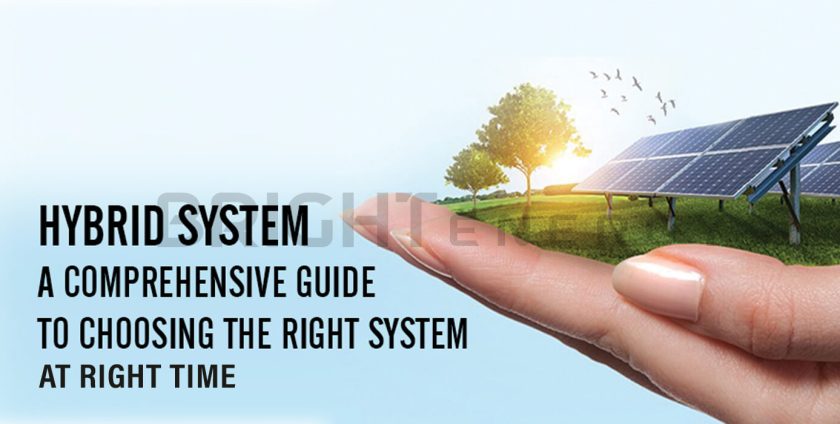
When people start to realize its high time to install the solar system in their home or business, they first learn about the different types of solar systems available in the market. Mostly there are three types, On-grid solar, Off-Grid Solar, and Hybrid System. Each type has its own pros and cons. We will discuss only Hybrid Solar System in this blog.
What is Hybrid Solar System?
As the name hybrid suggests, Hybrid systems can operate as On-Grid systems or Net Metering, and sell excess energy back to WAPDA when it’s beneficial. As the system is hybrid, two or more energy sources are being used to maintain a stable and interruption-free energy flow.
Hybrid Solar Systems offer a more versatile and self-sufficient energy solution. These systems integrate solar panels with energy storage, usually batteries, and can operate both connected to the grid and independently. Hybrid systems store excess solar energy in batteries for later use. It means you can power your home or business with solar energy even when the sun is not shining or during grid outages.
With a Hybrid Solar system, you reduce your reliance on the grid and have a reliable backup power source, making it an ideal choice for areas with unstable grid infrastructure or frequent power outages. In the daytime, the solar panel’s energy can be used. But as the sunlight dims in the evening or on a cloudy day, the grid electricity can be easily used as a backup if battery charging is over. In case of power shortage at night, users can opt for battery charging just like they use UPS power. In this way, Hybrid systems allow users to maximize their self-consumption of solar energy.
By reducing your reliance on the grid and using stored solar energy, Hybrid systems can further reduce your carbon footprint and environmental impact.
How Does Hybrid System Works?
The solar panels receive sunlight and convert it into DC or Direct Current. It goes to inverter where this current is converted into AC, the type which can be used easily by the machines and appliances of the home or business. At the same time, backup battery is also being charged.
The inverter is responsible to choose where to withdraw the current from. The first priority is to convert sunlight in DC and then into AC current for usage. In case, there is not enough sunlight to do so, the second option is to withdraw current from the batteries attached to the system. Number of batteries depends upon the system and usage. The third and last priority is Grid electricity. The inverter is responsible to channel the grid electricity if there is not enough current for usage.
This solar power system allows flexibility to the users to choose which option do they need at the moment. In normal conditions, days with full sunlight, solar power is enough but in emergency situations; end of battery’s charge, clouds, rain, fog, smog; or at night, grid or WAPDA’s electricity can be used.
When to Go for a Hybrid Solar System?
As we have discussed about how a hybrid solar system works, we will now discuss when to go for a hybrid solar system or under which conditions should we opt the hybrid solar system. Opting for a hybrid solar system in Pakistan, or any other location, depends on various factors specific to your energy needs, budget, and the local environment. Following are some of the cases:
Unreliable Grid Supply:
If you live in an area with an unreliable or intermittent grid supply, a hybrid solar system with energy storage (batteries) can provide a consistent power supply. During grid outage periods, the stored energy in batteries can power your home or business, ensuring an uninterrupted electricity supply.
Budget Considerations:
Hybrid solar systems are typically more expensive upfront due to the cost of batteries. If you have the budget for the initial investment, the long-term savings on electricity bills and the benefits of a reliable power supply might justify the expense.
Energy Independence:
If you aim to reduce your dependency on the grid and achieve energy independence, a hybrid solar system with batteries allows you to store excess energy generated during the day for use at night or during cloudy days. This setup can help you rely less on the grid and reduce your electricity bills significantly.
Variable Energy Needs:
If your energy needs vary throughout the day or if you have specific high-energy consumption periods, a hybrid system can balance the demand by utilizing solar power during the day and stored energy during peak usage times. It can help in optimizing your energy usage and managing costs effectively.
Peak Load Management:
Hybrid solar system is not only for home but businesses too. Businesses or industries with high peak energy demands can benefit from hybrid systems by using stored energy during peak load times. It can help reduce demand charges and overall electricity costs, making it a cost-effective solution for commercial enterprises.
Remote Areas or Off-Grid Applications:
In remote areas where the grid connection is unavailable or expensive to install, a hybrid solar system with batteries can provide a reliable source of electricity. These systems are particularly useful for powering off-grid homes, remote agricultural setups, or telecom towers.
Keeping this in mind, it can be used anywhere and for any purpose (home, business, agriculture) in Pakistan. But before deciding on a hybrid solar system, it’s crucial to conduct a thorough energy audit to understand your energy consumption patterns.
You can also consult Bright Energy to help you determine the most suitable system based on your specific requirements and local conditions.
Related Cool Links:
- By: Admin
- Tags: Hybrid Solar System, What is Hybrid Solar System?, When to Go for a Hybrid Solar System?
- 0 comment

Leave a Reply